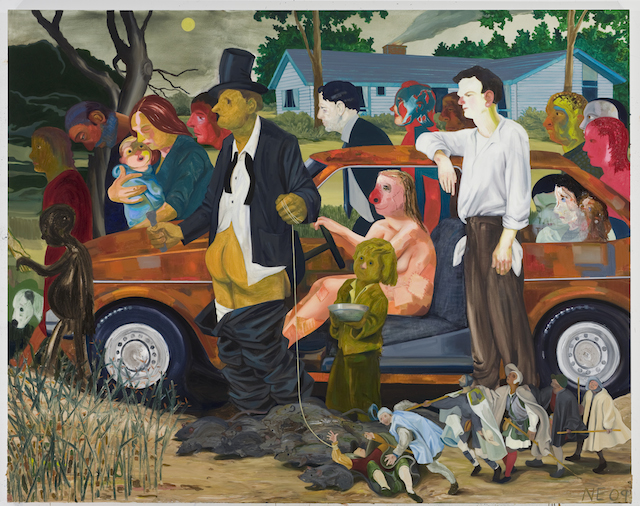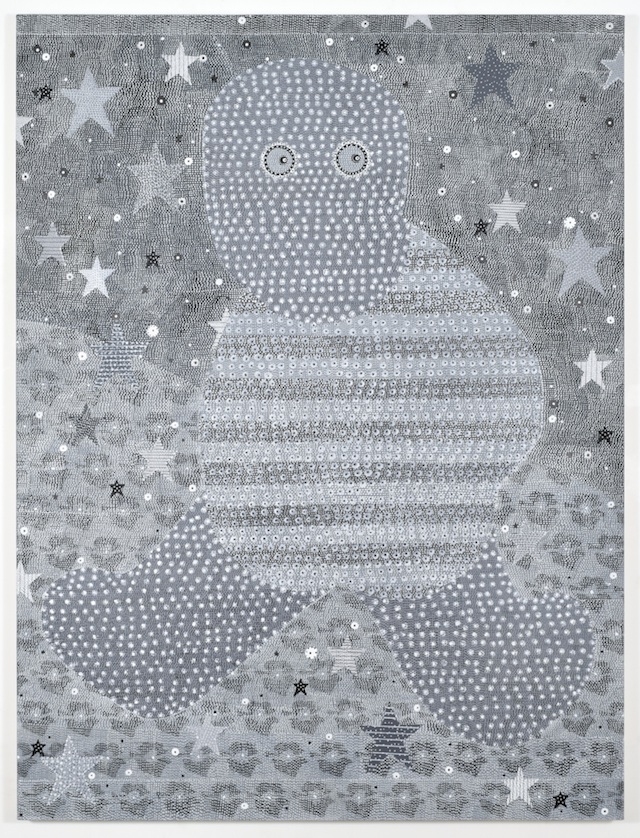
Nicole Eisenman. The Triumph of Poverty, 2009. Oil on canvas, 65 x 82 inches. Courtesy the artist. © Nicole Eisenman.
I will begin with a quote from Eric Fischl: “There’s nothing insincere about irony.” I couldn’t agree more. And I can’t bear the presumed opposition any longer. Can’t sincerity and irony live in relational ambivalence, for minds that can handle a pinch, or even a punch, of complexity? And who benefits from drawing such lines?
Art, artists, and audiences could better themselves by inviting complexities and eschewing comparative dialectics. More art critics and curators should take some time to learn what smart trans theorists already understand: that neither Bruce nor Caitlyn Jenner are interesting in themselves, that their being and becoming both identities simultaneously is the resonating intrigue. Moreover, media distribution is the real agent in the creation of any kind of identity or body these days (including bodies of artwork). Trans or not, one needs mediated validation to transition or have agency of any kind. Science isn’t enough to get the job done in the age of social media; one needs Diane Sawyer and Annie Liebowitz to produce and distribute one’s new self. So the network interview, not the surgical knife, finishes Bruce’s transformation into Caitlyn. Now Jenner is a nipped-and-tucked WASPy lady. And good for her. Whatever floats her boat.
To be clear, this text isn’t a promotional platform for trans theory.[1] Unlike the 1950s proponents of binary ideologies, contemporary trans thinkers seek out complexity, ambivalent spaces, and anarchical identities. Who else is doing that in the world, now? The art-world media places everyone into categories faster than you can say sixty-nine. For example, one is either provisional or rigorous, male or female, modern or post-, abstract or representational, gay or straight, ironic or sincere, personal or conceptual…
(snore…)
Oops, I fell asleep just writing that.
Thankfully, many trans theorists are looking at nature, where the qualities of gender and sex are so diverse it could make one’s head spin. In the essay “Animal Trans,” Myra J. Hird cites some research on female aphids that can clone themselves at will; they don’t need two genders to procreate. [2] If that isn’t creative freedom outside categories, then I don’t know what is. (Don’t get me started about Charles Darwin’s studies of barnacles!)
Artworks should be as diverse and nonnormative as nature. Why do we seem to love defining opposites? What good does it do us? Mushrooms have eighteen thousand genders; how do you build, let alone practice, social norms at that party? You don’t. And that’s the kind of party—in some post-avant-garde, dystopian-utopian dialectic—I thought we artists were supposed to be throwing: shattering norms, forging ruptures, not seeking beginnings or ends, dredging out anarchical forms of ethics as well as perverse, unsanctioned, unverifiable meanings and returns.

Glenn Goldberg. A Friend, 2015. Acrylic, gesso, ink and pencil on canvas; 84 x 63 inches. Courtesy Betty Cuningham Gallery, New York. © Glenn Goldberg.
Today, in an effort to brand, verify, and distribute works of art, meaning and form must be pared down to the most simplistic, easily understood forms. In our supposed pluralist times, it seems there still are sides in a battle for precious space in cultural production. Branding is in; complexity is an old toy that academics play with and that industry cares little about.
Irony and sincerity are aspects of brands. They are only generative when they exist together, intersexed. That makes them tools for artists, and it’s an artist job to use tools in unprecedented, unorthodox ways. Artworks should always fuck with the mechanisms of branding and the expected. Don’t settle for the red or blue pill; find the third pill, and figure out how to distribute that pill, in hopes that it may mitigate the tedium.
Here are four examples of great artists who use irony and sincerity in a trans way, a jockstraps-over-panties way.
Shelia Pepe
Shelia Pepe, an artist-sculptor-educator extraordinaire, walks around with all her woman parts and wears handmade ties of her own making, a mound of salt-and-pepper hair akin to that of a character in Goodfellas, and a mustache. She doesn’t identify herself as trans or gender queer but as a lesbian, a stance that sophisticated trans theorists would name. Pepe’s work embodies a nonconformist attitude of craft, sculpture, and strategies of installation, not to mention collaborations with craftworkers around the world during onsite installations. Pepe’s work is contemporary craft, following from the modern canon. Her work prompts us to think: Did we forget the Bauhaus commitment to creating living spaces where high and low aesthetics, the salon and craft, could exist together to be appreciated on the same level?
John Waters
A filmmaker known as the “People’s Pervert,” and an irreverent fan of filth, John Waters said, in his recent commencement speech at Rhode Island School of Design, that young people should design clothing “so hideous they can’t be worn ironically,” and that they should aim to make him nervous. [3] This is not an easy feat. How many artists are willing to make their audiences nervous? It doesn’t always pay, that’s for sure. Picking a side in an existing binary makes people more at home, comfortable. But great artists use ironic methods with sincere motivations: a cycle of ambivalent, contradictory chaos between intent and form, to create new kinds of experiences.
Nicole Eisenman
Nicole Eisenman has been a favorite artist of mine since the early ’90s. She is one of the funniest image makers alive. But what really makes her a great artist is that she can paint a front butt with empathy, as seen in The Triumph of Poverty (2009). Looking at her work is a fabulous experience because Eisenman conveys life’s terrifying sweetness and vulnerability in disgusting blobs of absurdity.
Glenn Goldberg
Glenn Goldberg’s work conjures evil toys and innocent stalkers, embedded in a narrative context that has no particular read. All at once, it is glorious and deadpan, minimal and maximal, cis-male-ancient and -adolescent.
These artists eviscerate mass media and all the while love the humanity in it.
—
[1] One fabulous book is Testo Junkie: Sex, Drugs, and Biopolitics by Paul Beatriz Preciado.
[2] M.J. Hird, “Animal Trans,” Australian Feminist Studies, 2006, 21(49): 35–48. Also published in N. Giffney and M. Hird, eds., Queering the NonHuman (Aldershot: Ashgate, 2008).
[3] Elisa Wouk Almino, “John Waters Tells Young Artists to ‘Wreck What Came Before,’”Hyperallergic, June 12, 2015, https://hyperallergic.com/214293/john-waters-tells-young-artists-to-wreck-what-came-before/.




Pingback: An Ivory Tower Artist: Joe Bradley's Recent Paintings, Sculptures, and Drawings
Pingback: ITeachGuitars – An Ivory Tower Artist: Joe Bradley's Recent Paintings, Sculptures, and Drawings
Pingback: An Ivory Tower Artist: Joe Bradley's Recent Paintings, Sculptures, and Drawings : PadiSkyDiver
Pingback: An Ivory Tower Artist: Joe Bradley's Recent Paintings, Sculptures, and Drawings | SewFreshFabrics